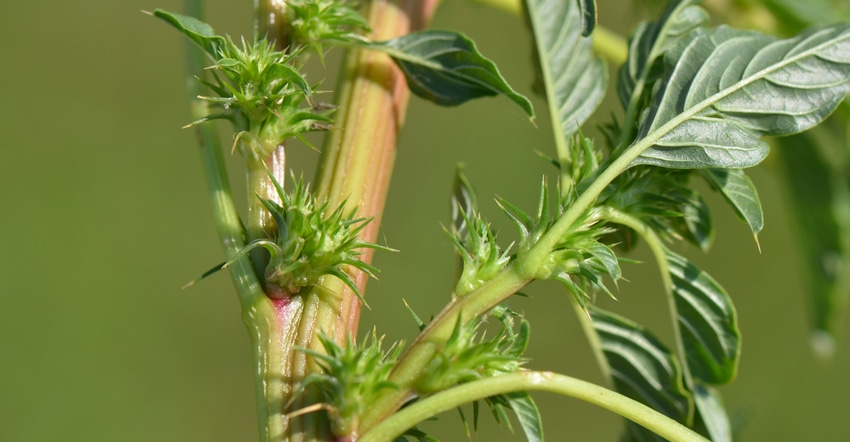
Minnesota farmers, scientists and state agency professionals have a success story to share when it comes to fighting invasive weeds, particularly Palmer amaranth.
While there are no guarantees that the aggressive weed won’t surface again in numbers, scientists with the Minnesota Department of Agriculture and the University of Minnesota Extension believe they have a model for eradication that other states might find useful.
In an article recently published in Weed Technology, a publication of the Weed Science Society of America, MDA and U-M Extension authors detail the state’s approach to preparing for and working toward elimination of the weed. The article, Timeline of Palmer amaranth (Amaranthus palmeri) invasion and eradication in Minnesota, highlights the collaborative work by farmers, Extension, MDA and others to identify Palmer in fields, determine its path into the state and implement strategies to eliminate infestations.
Palmer amaranth was first found in Minnesota in September 2016 in conservation plantings sown with Palmer amaranth-contaminated seed mixes. To date, Palmer amaranth has been found in nine counties in Minnesota. Most of the sites have been successfully eradicated of the weed, and those remaining are being closely monitored.
Left uncontrolled, a single female Palmer amaranth plant typically produces 100,000 to 500,000 seeds. It is resistant to multiple herbicides, can cause substantial yield losses, and can greatly increase weed management costs in soybeans and corn.
When work began
Several years prior to its discovery in Minnesota, Extension scientists were learning from colleagues at the University of Tennessee about the challenges of identifying and managing the weed. By 2014, Palmer was confirmed in Wisconsin, Iowa, Illinois, Nebraska and South Dakota. Its seed was believed to have spread by various means, such as movement of contaminated livestock feed and equipment, and planting seed from infested regions. Resistance to herbicides commonly used for management of weeds in corn and soybeans also contributed to the spread.
That same year, MDA, Extension and the state’s Noxious Weed Advisory Committee made a recommendation to designate Palmer amaranth as a Prohibited Eradicate Noxious Weed; and the following year, it was officially designated as Prohibited Eradicate, meaning all above- and belowground parts of the plant must be destroyed. Plus, the law prohibited transportation, propagation and sale of the plant.
In 2015, Extension specialists received numerous reports of Palmer amaranth in crop production fields. MDA surveyed 467 soybean fields that year but did not find Palmer.
In September 2016, Extension notified MDA of suspected Palmer amaranth. This time, Palmer amaranth seed was found to be a contaminant in a Conservation Reserve Program seed mix that was planted at 35 sites in Lyon and Yellow Medicine counties, with eight of these sites being confirmed as infested. MDA worked with landowners, surveyed each site and later torched the invasive plants. In subsequent years, Palmer was found in Todd, Douglas, Redwood, Jackson, Lincoln, Houston and Winona counties.
MDA continues to monitor recently infected sites, while other sites have been considered free of Palmer thanks to aggressive eradication efforts.
In 2016, MDA also deemed Palmer amaranth as a noxious weed seed, which requires all properly labeled seed sold in the state to be genetically tested for Palmer.
Educate, educate
Throughout the collaborative response, early detection and rapid response to Palmer amaranth infestations were critically important for preventing its spread, the article’s authors note.
“MDA and U-M Extension put a great deal of effort into educating landowners and the public about the threat and identification of Palmer amaranth,” they wrote. “Crop consultants and commodity organizations have added significantly to this effort. As a result, the number of reports submitted from concerned landowners significantly increased.”
MDA also made it easy for residents to report suspect invasive species through its Arrest the Pest program. Agency staff followed up on all reports that were suspected to be Palmer amaranth. After they made visual confirmation of Palmer amaranth plants at a given site, they took samples of all suspected plants and submitted them for genetic testing for species determination.
Lessons learned
According to the article’s authors, there were several lessons learned over the past five years through the state’s Palmer amaranth eradication efforts. The first lesson was the need for a robust, statewide, state-funded noxious weed program overseen by an independent advisory committee that worked closely with county agricultural inspectors and local weed inspectors. Second, stakeholder support — from the commissioner of agriculture to commodity groups and farmers — was needed for MDA and Extension to establish an aggressive protocol to not only eradicate Palmer populations on the ground, but also to communicate with the larger agricultural community and general public the seriousness of battling this invasive plant. And third, long-term success will be more likely if neighboring states are taking similar eradication measures. If they are not, it will be difficult to stay ahead of future infestations.
“Efforts to prevent the establishment and spread of Palmer amaranth has shown that regional efforts can be successful,” the authors concluded. “We were fortunate to have access to funds early on, and have statewide and regional support. Loss of funding for ongoing Palmer amaranth management and research could significantly reduce successful efforts. Communication between states to address spread pathways, testing strategies, ongoing research and management activities greatly increases the chance of long-term success with this aggressive agricultural pest.”
See MDA's Palmer amaranth webpage for more information on the noxious weed.
About the Author(s)
You May Also Like






